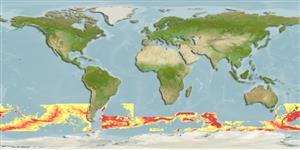Common names from other countries
>
Myctophiformes (Lanternfishes) >
Myctophidae (Lanternfishes) > Gymnoscopelinae
Etymology: Gymnoscopelus: Greek, gymnos = naked + Greek, skopelos, a lantern fish (Ref. 45335).
More on author: Andriashev.
Environment: milieu / climate zone / depth range / distribution range
Ökologie
seewasser benthopelagisch; ozeanodrom (Ref. 51243); tiefenbereich ? - 4200 m (Ref. 58018). Temperate; 34°S - 67°S, 58°W - 71°W
Generally ranges between Antarctic Polar Front and Subtropical Convergence, but with northern extension to about 38°S off Argentina, to 40°S off Chile and to 34°S in the southeast Atlantic.
Size / Gewicht / Alter
Maturity: Lm ? range ? - ? cm
Max length : 28.0 cm SL Männchen/unbestimmt; (Ref. 5182)
Rückenflossenstacheln (insgesamt): 0; Rückenflossenweichstrahlen (insgesamt): 19-22; Afterflossenstacheln 0; Afterflossenweichstrahlen: 19 - 22
Oceanic and mesopelagic (Ref. 4066). Found within the upper 200 m in the region of Antarctic Polar Front, but inhabits deeper northwards at night.
Life cycle and mating behavior
Geschlechtsreife | Fortpflanzung | Ablaichen | Eier | Fecundity | Larven
Hulley, P.A., 1990. Myctophidae. p. 146-178. In O. Gon and P.C. Heemstra (eds.) Fishes of the Southern Ocean. J.L.B. Smith Institute of Ichthyology, Grahamstown, South Africa. (Ref. 5182)
IUCN Rote Liste Status (Ref. 130435)
CITES (Ref. 128078)
Not Evaluated
Bedrohung für Menschen
Harmless
Nutzung durch Menschen
Fischereien: weniger kommerziell
Mehr Information
NamenSynonymeMetabolismusRäuberÖkotoxikologieFortpflanzungGeschlechtsreifeAblaichenFecundityEierEientwicklung
ReferenzenAquakulturAquakultur ProfilZuchtlinienGenetikElectrophoresesVererbbarkeitKrankheitenVerarbeitungMass conversion
PartnerBilderStamps, Coins Misc.LauteCiguateraGeschwindigkeitSchwimmstilKiemenoberflächeOtolithsGehirngrößeSehfähigkeit
Tools
Zusatzinformationen
Download XML
Internet Quellen
Estimates based on models
Preferred temperature (Ref.
115969): 1.5 - 5.6, mean 2.6 (based on 596 cells).
Phylogenetic diversity index (Ref.
82804): PD
50 = 0.5039 [Uniqueness, from 0.5 = low to 2.0 = high].
Bayesian length-weight: a=0.00407 (0.00222 - 0.00749), b=3.23 (3.06 - 3.40), in cm Total Length, based on LWR estimates for this species & (Sub)family-body (Ref.
93245).
Trophic level (Ref.
69278): 3.3 ±0.47 se; based on food items.
Widerstandsfähigkeit (Ref.
120179): niedrig, Verdopplung der Population dauert 4,5 - 14 Jahre. (Preliminary K or Fecundity.).
Fishing Vulnerability (Ref.
59153): Low vulnerability (24 of 100).
